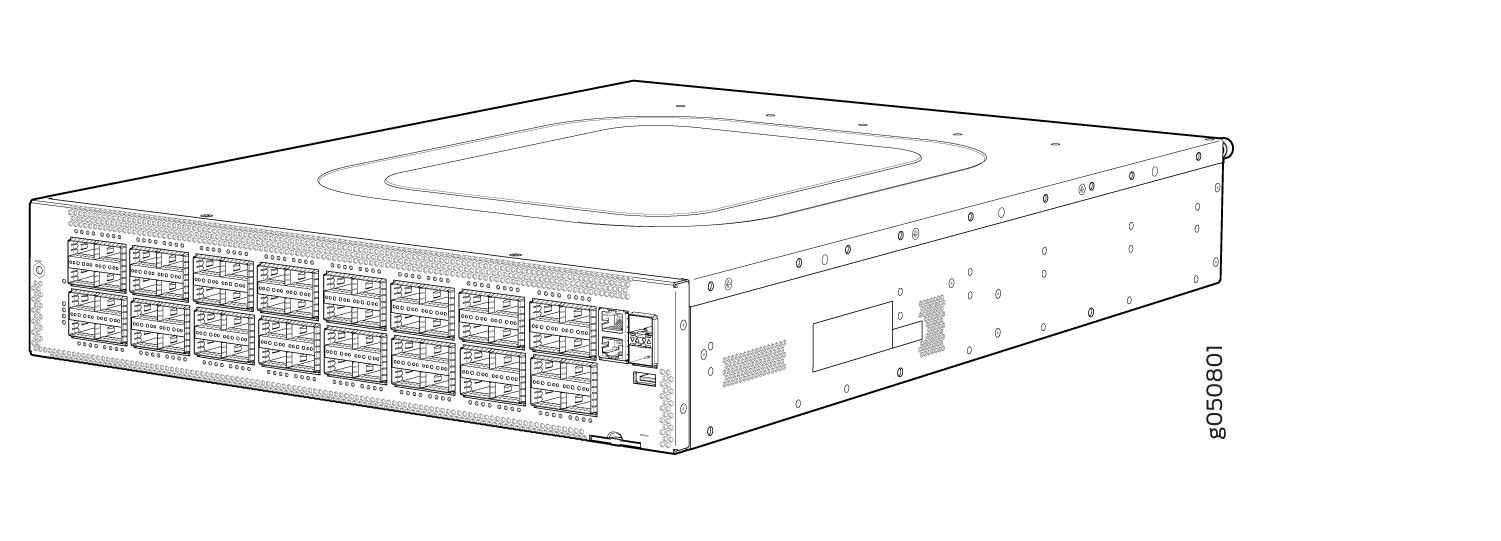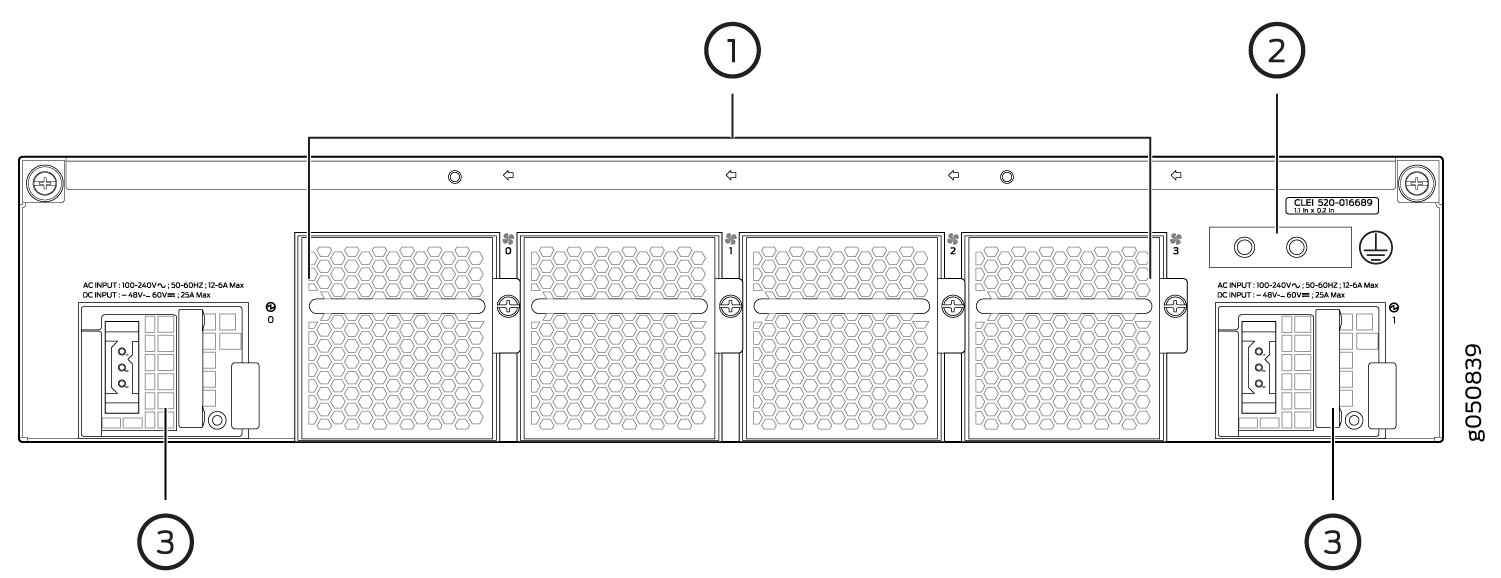QFX5210 System Overview
QFX5210 Switch Description
The QFX5210 line offers line-rate, low-latency 10/25/40/100GbE switches for building large IP fabrics. QFX5210 Switches are an optimal choice for spine-and-leaf IP fabric deployments as well as metro use cases.
This topic covers:
QFX5210-64C Hardware
The QFX5210-64C is a flexible 2 U standalone switch designed for spine-leaf deployments that need high-port density. The routing engine and control plane are driven by the 2.2 GHz quad-core Intel® Xeon® CPU with 16 GB of memory and an enterprise grade 100 GB solid-state drive (SSD) for storage.
As shown in Figure 1, the QFX5210-64C is a 100 Gigabit Ethernet spine and leaf switch that supports both quad small form-factor pluggable (QSFP+), 100-Gbps QSFP+ (QSFP28) transceivers, and break out cables in the 64 QSFP28 sockets. The ports 0 through 63 can be configured as either uplinks or as access ports. The QSFP28 ports are configured as 100-Gigabit Ethernet ports by default, but can also be configured to speeds of 50, 40, 25, or 10-Gigabit Ethernet. There are also two dedicated SFP+ ports on the port panel.
The QFX5210-64C comes standard with redundant fans and redundant power supplies. The switch can be ordered with either ports-to-FRUs or FRUs-to-ports airflow and with AC or DC power supplies.

Benefits of the QFX5210-64C Switch
The QFX5210-64C is designed for cloud customers who can benefit from:
A solution that can future proof and provide investment protection
Having open and standards based switches in a multi-vendor network
Simplified installation and upgrades by using ZTP and ISSU
Channelization
Ports default to 100-Gigabit Ethernet. Port speeds of 40 Gbps or 100 Gbps are automatically set when the QSFP+ or QSFP28 transceiver is inserted into the port or on reboot. Channelization is only allowed in FlexiPic system mode. Some ports have restrictions on the supported channelization speed. The combination of channelized and non-channelized ports cannot go above the system limit of 128 interfaces. For full details on channelization, see QFX5210-64C Port Panel .
When the port is configured for 40-Gigabit Ethernet and a 4x10G breakout cable is detected in ports 0 through 31, the system converts the port into 4 independent 10-Gigabit Ethernet ports
When the port is configured for 100-Gigabit Ethernet and a 2x50G breakout cable is detected, the system converts the port into 2 independent 50-Gigabit Ethernet ports
When the port is configured for 100-Gigabit Ethernet and a 4x25G breakout cable is detected in ports 0 through 31, the system converts the port into 4 independent 25-Gigabit Ethernet ports
System Software
QFX Series devices use the Junos operating system (OS), which is installed on a one of the QFX5210 switch’s internal solid-state flash drive. The same Junos OS code base that runs on QFX5210 switches also runs on all Juniper Networks EX Series switches, and M Series, MX Series, and T Series routers.
The QFX5210-64C switch is supported on Junos OS Release 18.1R1 and later.
Software features are categorized into three tiers: base, premium, and advanced:
Junos OS base features such as Layer 2 and Layer 3 switching, multicast, automation, programmability, Zero Touch Provisioning (ZTP), and basic monitoring are enabled by default from the factory.
Junos OS premium features such as Border Gateway Protocol (BGP), Intermediate System-to-Intermediate System (IS-IS), and Virtual Extensible Local Area Network (VXLAN) require a QFX5K-C2-PFL license on each QFX5210 switch to use these features.
Junos OS advanced features include Multiprotocol Label Switching (MPLS) in addition to all of the premium features. A QFX5K-C2-AFL license is required on each QFX5210 switch to use these features.
If a premium or advanced feature is configured on the QFX5210 without a valid license, an alarm is raised and system log (syslog) messages are generated.
For more information about which features are supported on QFX Series devices, see Feature Explorer.
You manage the switch using the Junos OS command-line interface (CLI), accessible through the console and out-of-band management ports on the device.
See Also
QFX5210 Hardware Component Overview
The QFX5210 supports the components in listed in alphabetic order.
Component |
Spare Juniper Model Number |
CLI Output |
|---|---|---|
Chassis |
QFX5210-64C-CHAS |
|
Fan module |
QFX5210-FANAFI (FRUs to ports airflow) QFX5210-FANAFO (Ports to FRUs airflow) |
|
Power supplies |
JPSU-1100W-AC-AFI (FRUs to ports airflow) JPSU-1100W-AC-AFO (Ports to FRUs airflow) JPSU-1100W-DC-AFI (FRUs to ports airflow) JPSU-1100W-DC-AFO (Ports to FRUs airflow) |
|
Rack mount kit |
QFX5210-4PST-RMK |
Not applicable |
See Also
QFX5210 Component Redundancy
The following hardware components provide redundancy on a QFX5210 switch:
Power supplies—The QFX5210 switch has two power supplies. Each power supply provides power to all components in the switch. If two power supplies are installed, the two power supplies provide full power redundancy to the device. If one power supply fails or is removed, the second power supply balances the electrical load without interruption.
To provide power redundancy to the system both power supplies must be installed. Connect power source feed A to one power supply and power source feed B to the second power supply.
CAUTION:Do not connect feed A and feed B to the same power supply input terminal.
Cooling system—The QFX5210 has four fan modules. If a fan module fails and is unable to keep the QFX5210 switch within the desired temperature thresholds, chassis alarms occur and the QFX5210 switch can shut down.
QFX5210 Field-Replaceable Units
Field-replaceable units (FRUs) are components that you can replace at your site. The QFX5210 FRUs are hot-insertable and hot-removable–you can remove and replace one of them without powering off the switch or disrupting the switching function.
Replace a failed power supply with a blank panel or new power supply within one minute of removal to prevent chassis overheating. The switch continues to operate with only one power supply running.
Table 2 lists the FRUs for the QFX5210 device and actions to take before removing them. See Figure 2 for the location of power supplies and fan modules.
FRU |
Required Actions Before Removal |
|---|---|
Power supplies (2) |
None. |
Fan modules (4) |
None. |
Optical transceivers |
None. We recommend that you disable the interface using the set interfaces interface-name disable command before you remove the transceiver. See Disconnecting a Fiber-Optic Cable from a QFX Series Device. |

1 — Fan modules (4) | 3 — Power supplies (4) |
2 — Protective earthing terminal |
If you have a Juniper Care service contract, register any addition, change, or upgrade of hardware components at https://www.juniper.net/customers/support/tools/updateinstallbase/ . Failure to do so can result in significant delays if you need replacement parts. This note does not apply if you replace existing components with the same type of component.
